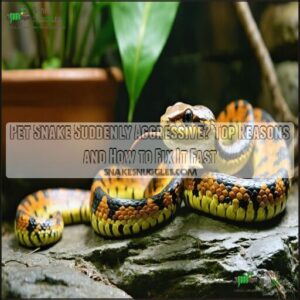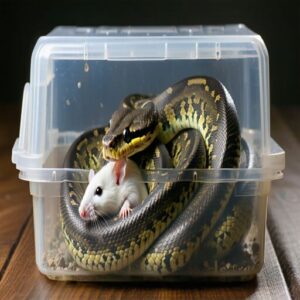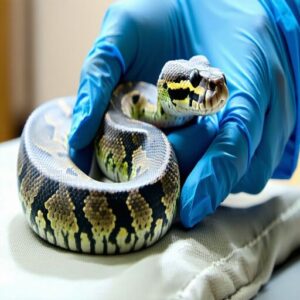This site is supported by our readers. We may earn a commission, at no cost to you, if you purchase through links.

Hunger is a common culprit; if feeding time’s overdue, your snake might confuse you for its next meal. Shedding can also make snakes grumpy, as their skin feels tight and sensitive.
Environmental changes, like new lighting, noise, or a drafty enclosure, can stress them out too. Health issues or over-handling could also be to blame.
Observe its behavior and check for signs like striking, hissing, or agitated movements. Adjust its care and environment carefully—curious how to prevent future outbreaks? Stay tuned for tips on how to improve your snake’s environment and prevent aggressive behavior, and learn more about preventing future issues.
Table Of Contents
- Key Takeaways
- Why is My Snake Aggressive?
- Common Causes of Aggression
- Recognizing Aggressive Behavior in Snakes
- Managing and Reducing Aggression
- Preventing Future Aggression
- Frequently Asked Questions (FAQs)
- How to deal with aggressive pet snakes?
- Why is my snake aggressive?
- Are upset snakes aggressive?
- Do snakes act aggressively?
- Why is my snake aggressive after feeding?
- What is the difference between aggressive and defensive snakes?
- Why is my snake being aggressive all of a sudden?
- Why is my snake biting me all of a sudden?
- How to deal with an aggressive pet snake?
- Why is my snake suddenly hissing at me?
- Conclusion
Key Takeaways
- Check your snake’s enclosure for proper temperature, humidity, hiding spots, and cleanliness to reduce stress and aggression.
- Stick to consistent feeding schedules and properly sized prey to avoid hunger-driven aggression and stress.
- Avoid over-handling, especially during shedding or right after feeding, as it can make your snake feel defensive or vulnerable.
- Pay attention to your snake’s body language and changes in behavior, and consult a vet if aggression persists or signs of illness appear.
Why is My Snake Aggressive?
When your usually calm snake starts acting aggressive, it’s often their way of saying something’s wrong.
Understanding the reasons behind this behavior can help you address their needs and restore their sense of security.
Hunger and Feeding Issues
Hunger can flip your snake’s behavior fast, turning it from chill to striking. When feeding schedules slip, or prey size isn’t right, snake feeding aggression often follows.
Hunger can turn a calm snake into a striker—consistent feeding keeps their instincts in check.
A hungry snake’s instincts kick in, mistaking movement—even your hand—for food.
Look for these hunger signals:
- Increased activity at night, often paired with pacing or climbing.
- Striking at vibrations or anything moving near the enclosure.
- Rapid tongue flicking when you’re nearby, signaling food anticipation.
To avoid hunger strikes or food association issues, stick to consistent feeding schedules. Match the prey size to your snake’s species and age; too small, and they’ll stay hungry, too large, and regurgitation issues can arise. Selecting the correct snake food products is essential for their well-being. Proper feeding frequency keeps your snake calm, healthy, and stress-free.
Shedding and Skin Irritation
Shedding discomfort can make your snake moody. During this time, their vision clouds over, leaving them feeling exposed and uneasy.
Clouded vision during shedding leaves snakes vulnerable and uneasy—give them space and perfect humidity to ease their discomfort.
Skin irritation from retained shed or potential issues like scale rot can worsen their behavior. You might notice rubbing against objects or incomplete sheds, both signs of shedding trouble.
Avoid handling during this phase—snake aggression often spikes when they feel vulnerable.
Keep humidity levels perfect to prevent complications like blister disease or mite infestations. Proper care guarantees shedding is smoother, reducing irritability and improving snake behavior overall.
Environmental Changes and Stress
Environmental stress can make even the calmest snake act out.
A stressed snake often reacts defensively when its enclosure conditions are disrupted.
Common triggers include:
- Relocation stress from moving to a new habitat.
- Temperature shifts that upset their comfort zone.
- Lighting changes that confuse their natural cycles.
- Habitat disruption like rearranged hides or decor.
- Noise sensitivity from loud sounds or vibrations.
Introduce changes slowly, keeping the snake environment stable.
A calm, predictable setup reduces snake aggression and keeps them happy.
Health Issues and Pain
Health issues can turn even the calmest snake defensive.
Pain indicators like wheezing, mouth sores, or red bellies often signal deeper problems. Behavioral changes, such as increased snake aggression, might hint at illness symptoms or injuries.
A vet consultation guarantees proper injury assessment and care.
| Symptom | Cause | Action |
|---|---|---|
| Wheezing | Respiratory infection | Immediate vet visit |
| Excessive soaking | Mites or dehydration | Treat parasites |
| Scaly patches | Skin infection | Veterinary check-ups |
Spotting snake illness early prevents prolonged discomfort. Don’t delay seeking help!
Handling and Over-Handling
Overhandling can turn even a calm snake defensive.
Stress from excessive interaction often shows through:
- Frequent defensive strikes
- Stress-induced hissing
- Escape attempts during handling
- Appetite drops or skipped meals
- Tense, coiled body language
Stick to short, gradual socialization sessions—5-10 minutes works best.
Use proper handling techniques, like the “confident grab,” and tools for safety.
Understanding defensive posturing signs can help prevent escalation.
Balance handling frequency with rest to avoid triggering snake aggression and guarantee trust builds over time.
Common Causes of Aggression
When your snake suddenly acts aggressive, it’s often a sign something in its environment isn’t quite right.
Factors like improper temperatures, poor hygiene, or a lack of hiding spots can easily stress your pet and trigger defensive behaviors.
Improper Enclosure Conditions
An improperly set up snake enclosure can cause stress, leading to defensive behaviors.
If the enclosure size doesn’t allow natural movement or lacks temperature gradients and humidity levels, your snake may feel uneasy. Add secure hiding spots to help them feel safe, and choose a substrate that suits their species.
Poor ventilation or water dish placement can also create environmental stress. Think of the enclosure as your snake’s personal sanctuary—keeping it clean, comfortable, and well-maintained reduces snake aggression and promotes a calmer, happier pet.
Prioritize escape-proof enclosure materials for your snake’s safety, ensuring a stress-free environment that supports their overall well-being, and helps prevent defensive behaviors.
Inadequate Temperature and Humidity
If your pet snake’s suddenly aggressive, it might be feeling the heat—or lack of it. Snakes rely on temperature gradients and humidity levels to regulate their mood and health.
Without proper thermoregulation, they can develop shedding problems, respiratory issues, or display defensive behaviors like striking.
Aim for a warm side of 88-92°F, a cooler side around 75-80°F, and humidity between 50-60% for most species. Use digital hygrometers and thermostats to keep conditions steady.
- Mist daily to maintain ideal humidity.
- Prevent burns by using heat mats with thermostats.
- Boost shedding by temporarily raising humidity during the process.
Consider using a reptile under tank heater for ideal temperature control. A balanced setup keeps your snake calm and less likely to lash out.
Lack of Hiding Places and Visual Barriers
Feeling exposed can make your pet snake defensive, leading to sudden aggression. Adding hiding spots and visual barriers in the enclosure is a simple yet powerful way to promote snake wellbeing and reduce stress. Think of these as their “safe rooms” where they can unwind.
A thoughtfully designed habitat creates enclosure security and behavioral enrichment. Use cork bark, branches, or artificial plants to mimic their natural environment. Many owners choose to purchase premade hides for convenience.
Here’s a quick guide to habitat design:
| Area | Basic Setup | Ideal Setup | Benefits |
|---|---|---|---|
| Floor | Bare | Cork hides | Stress reduction |
| Walls | Empty | Plant cover | Visual barriers |
| Interior | Single hide | Multiple hides | Privacy |
| Decor | Minimal | Branches, rocks | Enrichment |
| Layout | Sparse | Cluttered naturally | Comfort, security |
The use of visual barriers, hiding spots, and a cluttered naturally layout can significantly enhance the snake’s environment, promoting a sense of security and reducing stress. By incorporating these elements, owners can create a more comfortable and enriching space for their pets.
Incorrect Lighting and Noise Levels
Your snake’s sudden aggression might be tied to lighting impact or noise stressors.
Bright lights can cause circadian disruption, throwing off their natural day-night rhythm and leading to behavioral changes. Stick to soft, indirect lighting to avoid sensory overload.
On the flip side, excessive noise, like TVs or loud music, creates environmental stress and agitates your snake. Keep their enclosure away from noisy areas, and consider foam padding to reduce noise pollution.
A calm, quiet space helps maintain balanced pet snake behavior and prevents an aggressive snake.
Poor Substrate and Hygiene
A dirty substrate can lead to bacterial growth, skin irritation, and even snake aggression.
Poor hygiene in the enclosure causes odor issues and discomfort, making your snake defensive.
To keep your pet happy and healthy, follow these steps:
- Spot-clean daily to remove waste, uneaten food, and control odors.
- Deep-clean weekly, replacing all substrate to prevent bacterial buildup and skin problems.
- Choose the right substrate type, like cypress mulch or aspen shavings, which support humidity and comfort.
A clean enclosure means a calmer, healthier snake!
Recognizing Aggressive Behavior in Snakes
Understanding your snake’s body language is key to spotting signs of aggression before things escalate.
From hissing to striking, these behaviors aren’t personal—they’re your pet’s way of saying something’s not quite right.
Body Language and Posturing
Your snake’s body language speaks volumes.
Defensive postures like coiling, body flattening, or tail vibration often signal stress or fear. Rapid tongue flicking can mean heightened awareness, while a raised head or puffed throat indicates a threat display.
Here’s a cheat sheet:
| Behavior | Meaning | Action to Take |
|---|---|---|
| Coiling tightly | Feeling threatened | Give space |
| Body flattening | Trying to appear larger | Move slowly, avoid touch |
| Tail vibration | High stress or fear | Reduce nearby stimuli |
| Tongue flicking | Monitoring surroundings | Stay calm, observe |
| Striking motion | Defensive aggression | Back off immediately |
Vocalization and Hissing
Ever wonder what your snake’s hissing really means? Hissing variations are key defensive signals, often tied to stress or fear.
A snake amplifies its vocalizations to warn you it’s uncomfortable. Watch for these signs:
- Puffing up while hissing to appear intimidating.
- Frequent hissing when approached or handled.
- Triggered hissing from sudden movements or loud noises.
- Persistent hissing near its enclosure, hinting at environmental stress.
Take time to reassess its setup—calming its space reduces snake aggression and defensive behavior.
Striking and Biting
Striking and biting are your snake’s way of saying, “Back off!”
Fear drives these defensive bites, not true aggression.
Watch for the S-shaped neck curve or raised head—classic signs of snake striking.
Defensive bites differ from prey-driven strikes, but both show the snake feels threatened.
If bitten, stay calm, clean the wound, and give your snake space.
Understanding snake aggression causes like Bite Force or Strike Accuracy helps you handle with care.
Approach cautiously to avoid triggering Venomous Strikes or Constriction Risks.
| Behavior | Trigger | Risk Level |
|---|---|---|
| Defensive Bite | Fear or stress | Moderate |
| Prey Strike | Hunger or confusion | High |
| Missed Strike | Environmental stress | Low |
| Raised Head | Defensive posture | Low |
| S-Shape Curve | Imminent strike | High |
Escaping and Attempting to Flee
If your snake seems determined to escape, it’s likely feeling stressed or uncomfortable.
Escape attempts can reveal issues like poor enclosure security or unsuitable conditions.
Watch for these signs:
- Persistent corner-pushing suggests frustration with the enclosure setup.
- Frantic movements during handling point to fear or unease.
- Constant escape-seeking signals environmental stress, like improper temperatures or missing hiding spots.
To reduce snake aggression and fleeing signs, check enclosure conditions, improve hiding spots, and address environmental stress for better security and comfort.
Changes in Appetite and Feeding
If your snake’s appetite shifts—like refusing food, showing sudden aggression during feeding, or regurgitating meals—it’s a red flag.
Double-check the prey size and feeding frequency; both can affect feeding response.
Stress from overhandling or environmental issues might also play a role. Stick to consistent feeding schedules and monitor for food refusal or regurgitation causes.
Understanding a snake’s carnivorous diet helps guarantee proper feeding practices.
Persistent issues? Consult a vet to rule out health problems or supplementation needs.
Managing and Reducing Aggression
Managing aggression in your pet snake starts with understanding its triggers and making thoughtful adjustments to its care routine.
By addressing factors like feeding schedules, enclosure setup, and stress levels, you can help your snake feel secure and reduce defensive behaviors.
Adjusting Feeding Schedules and Techniques
An aggressive snake often signals feeding issues. A consistent feeding schedule helps regulate their feeding response, keeping them calmer. Adjust feeding frequency based on age—young snakes eat more often, adults less. Prey size matters too; too small leaves them hungry, too large causes stress. A key factor is to verify prey quality and nutrition to satisfy their needs.
Try these tips:
- Use frozen-thawed prey to avoid injuries from live food.
- Feed in a separate container to reduce enclosure aggression.
- Wait 48 hours post-meal before handling to prevent stress.
- Watch for striking or recoiling—signs your snake’s feeding routine needs tweaking.
Fine-tuning these habits can make a big difference.
Improving Enclosure Conditions and Enrichment
Your snake’s enclosure might need some TLC.
Make sure to provide proper temperature gradients and humidity control to match their natural habitat—invest in reliable systems for consistency.
Add enrichment items like hides or branches to create stimulating spaces.
Safe, easy-to-clean substrate options can prevent discomfort and maintain hygiene.
Don’t forget space optimization; a cramped snake enclosure can lead to unnecessary stress.
Keep water bowls fresh and place the habitat in a quiet spot.
A well-maintained enclosure with thoughtful enrichment minimizes stress and encourages a calm, happy snake, making it easier for both of you to relax.
This setup ensures your snake’s environment is natural and stimulating.
Reducing Stress and Handling
Snake aggression often stems from stress, so reducing it begins with how you handle them.
When interacting, prioritize safety and calmness—yours and theirs. Stress reduction doesn’t mean avoiding handling altogether but focusing on gentle handling and gradual socialization.
Here’s how to approach it:
- Be Patient: Don’t rush—the snake’s comfort comes first.
- Utilize Handling Tools: Hooks or gloves can protect both you and the snake.
- Practice Confident Grabs: Securely support their midsection to deter defensive reactions.
Balanced interaction matters too—overhandling stresses snakes, while avoiding them entirely amplifies fear.
Aim for short sessions, slowly extending time as trust builds. With a bit of patience and the right snake handling techniques, you’ll foster a calmer, trusting companion.
Providing Hiding Places and Visual Barriers
Feeling stressed? Your snake probably is too.
A secure enclosure with hiding spots and visual barriers works wonders for their mood.
Add materials like logs, rocks, or cozy store-bought hides to create safe retreats. Think of it as their personal “do not disturb” zone.
Plants or decorations also offer visual security, keeping disturbances at bay.
Tailor the enclosure setup to your snake’s species needs—this reduces snake aggression and helps them feel calmer.
Remember, stress reduction starts with thoughtful spaces where they can relax unseen.
Monitoring Health and Addressing Pain
Sometimes, a sharp change in reaction is your snake’s way of saying, "Something’s not right here." Behavioral changes like refusing food, sluggishness, or constant hiding can signal pain or illness. Early detection is essential.
If your pet shows defensive postures or recoils from touch, it’s time for an injury assessment. Look closely for cuts, swelling, abnormal scales, or breathing troubles. Don’t wait—snake aggression often stems from discomfort, and ignoring it won’t make things better.
Make veterinary checkups part of your routine. A vet can diagnose snake health issues like infections, respiratory problems, or injuries you might miss. Nothing beats professional care for restoring calm.
- What to monitor:
- Pain indicators (recoiling or striking).
- Weight loss or anorexia.
- Labored breathing.
- Excess grooming or agitation.
Preventing Future Aggression
Preventing future aggression in your snake starts with consistent care and attention to its environment.
By creating a setup that meets its needs and staying mindful of stress factors, you’ll help guarantee a calm and healthy pet.
Regular Maintenance and Cleaning
Keeping a clean enclosure is more than just good housekeeping—it’s about ensuring your pet snake stays healthy and relaxed.
A tidy home reduces stress and keeps snake aggression in check. With a consistent cleaning schedule, you’ll maintain ideal enclosure conditions effortlessly.
Here’s how to keep your snake’s habitat in top shape:
- Waste removal: Remove feces and uneaten prey daily to prevent bacteria growth and odor issues.
- Substrate sanitation: Regularly replace the bedding to maintain freshness, prevent mold, and support proper humidity.
- Water quality: Clean and refill the water dish daily to avoid contamination.
- Enclosure disinfection: Deep clean and sanitize the entire enclosure monthly to kill hidden germs and mites.
- Tool hygiene: Always use cleaned, sanitized tools to prevent introducing harmful bacteria.
By sticking to this routine, you’ll create a safe, mold-free environment, keeping your pet calm and comfortable in its snake enclosure.
Monitoring Environmental Conditions
A well-balanced enclosure keeps your snake calm and stress-free.
Focus first on temperature gradients—daytime temperature should range from 75–85°F. Monitor humidity control, aiming for 40–60% to prevent dehydration or shedding problems.
Use consistent lighting cycles of 12 hours to replicate their natural habitat. Make certain the enclosure size fits their needs, with proper ventilation quality for fresh airflow.
Regularly check these environmental factors to maintain comfort. When everything’s just right, your snake will feel safe and secure, reducing defensive behaviors and keeping them happy.
Providing a Stimulating Environment
Boosting your snake’s happiness starts with effective enclosure enrichment. Add climbing branches, puzzle feeders, and textured surfaces to promote natural behaviors and keep activity levels up.
Include shelters like logs or rock formations—they’ll feel secure while exploring. Switching up decorations every few weeks offers mental stimulation and reduces monotony, much like rearranging furniture brightens your living space.
Think of the setup as a blend of creativity and environmental design. Each tweak cuts down on stress and prevents snake aggression caused by boredom or discomfort.
Happy snakes live healthier, calmer lives, and small enrichment efforts can make a big difference in reducing defensive behavior and improving their overall well-being.
Avoiding Over-Handling and Stress
Over-handling can lead to snake aggression, but you can avoid it with proper techniques and gradual socialization.
Limit handling to 10-15 minutes twice weekly, ensuring a calm environment. Watch for stress signs like hissing or quick retreats. Handle confidently, respecting their space.
- Recognize stress: Avoid handling after feeding or during shedding, as snakes feel most vulnerable then.
A gentle approach with consistent handling techniques helps reduce stress while building trust over time.
Scheduling Regular Veterinary Check-Ups
Visiting a reptile vet isn’t just about emergencies—it’s about proactive care. Snakes often hide health issues until it’s late, making regular check-ups essential for early detection.
Specialized vets can spot subtle signs of trouble, like respiratory problems or sudden aggression linked to undetected health issues.
- Don’t wait for a crisis to act! Stick to annual exams, or more often if your vet recommends.
Keep notes on your snake’s medical history for consistent care. Preventative care saves money, reduces stress, and helps you bond with a happier, healthier snake.
Frequently Asked Questions (FAQs)
How to deal with aggressive pet snakes?
Dealing with an aggressive snake is like defusing a tiny, scaly bomb—assess stressors like temperature, handling, or hunger, adjust their habitat, handle sparingly, and consult a reptile vet if behavior persists.
Calm patience works wonders.
Why is my snake aggressive?
Your snake’s aggression could stem from stress, improper handling, hunger, shedding, or health issues.
Check its enclosure, verify proper conditions, and look for signs of illness or discomfort.
Consistency and patience help reduce defensive behavior, and ensuring proper care is crucial for the snake’s well-being, including addressing issues related to health.
Are upset snakes aggressive?
Sudden shifts signal stress or survival instincts, not simmering spite.
An upset snake may hiss, strike, or puff up when threatened.
Stay calm, adjust their environment, and remember—they’re defensive, not deliberately aggressive, this behavior is a sign of being defensive, and acting on survival instincts.
Do snakes act aggressively?
Snakes don’t act aggressively by nature—they react defensively when stressed or threatened.
Their behaviors, like hissing or striking, are self-protective. Understanding triggers, like sudden movements or improper handling, helps prevent these reactions and build trust.
Why is my snake aggressive after feeding?
After feeding, snakes can become irritable due to digestion or territorial instincts.
Handling too soon disrupts their process, making them defensive. Wait 48 hours post-feeding before handling to guarantee they feel secure and calm.
What is the difference between aggressive and defensive snakes?
Defensive snakes react out of fear or stress, using displays like hissing or striking to protect themselves.
While aggressive snakes actively assert dominance or fight, defensive behavior’s survival-focused, whereas aggression’s about asserting control.
Why is my snake being aggressive all of a sudden?
Your snake might feel stressed, sick, or threatened.
Check its enclosure for proper temperature, hiding spots, and cleanliness.
Sudden changes, hunger, or shedding could be triggers. If unsure, consult a reptile vet for guidance.
Why is my snake biting me all of a sudden?
Your snake might bite due to stress, shedding discomfort, hunger, or feeling cornered.
Check enclosure conditions, feeding schedule, and recent changes.
Handle calmly with care, ensuring your snake feels safe, not threatened or overwhelmed.
How to deal with an aggressive pet snake?
When your snake acts up, it’s likely feeling stressed or unwell.
Check its enclosure—temperature, humidity, and hiding spots matter.
Handle sparingly, use tools for safety, and consult a vet if behavior doesn’t improve.
Why is my snake suddenly hissing at me?
Your snake’s hissing might mean it feels stressed, threatened, or unwell.
Changes in environment, handling, shedding, or illness can trigger this.
Check enclosure conditions and handling habits, and consider a vet if behavior persists, as your snake’s hissing might indicate it is unwell.
Conclusion
Imagine this scenario: your once calm pet snake suddenly aggressive, coiled in defense, and striking unexpectedly.
It’s frustrating, but with small changes, you can restore its calm. Check feeding schedules and enclosure conditions—snakes get grumpy when hungry or stressed.
Address shedding sensitivity, make certain of proper temperature and hiding spots, and avoid over-handling. Pay attention to its body language, and don’t ignore potential health concerns.
With consistent care, you’ll prevent future issues and keep your snake healthy and content.
- https://academic.oup.com/beheco/article/15/2/365/223992
- https://journals.ku.edu/reptilesandamphibians/article/view/16079/14405
- https://www.ncbi.nlm.nih.gov/pmc/articles/PMC5865084/
- https://goodcompanionsvets.co.uk/wp-content/plugins/vetstream_swagger/pet-health/pet/pet_info_print.php?vetstream-type=ZXhvdGlzL3JlcHRpbGVz&nodeguid=a707b301-ade1-4c4d-b197-abce2d2ebc62
- https://www.livescience.com/33325-snake-flick-tongue.html



















